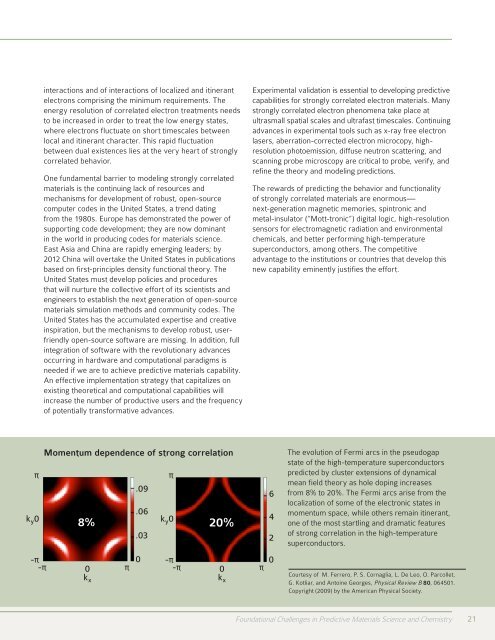Computational Materials Science and Chemistry ... - Office of Science
Computational Materials Science and Chemistry ... - Office of Science
Computational Materials Science and Chemistry ... - Office of Science
Create successful ePaper yourself
Turn your PDF publications into a flip-book with our unique Google optimized e-Paper software.
π<br />
k y0<br />
interactions <strong>and</strong> <strong>of</strong> interactions <strong>of</strong> localized <strong>and</strong> itinerant<br />
electrons comprising the minimum requirements. The<br />
energy resolution <strong>of</strong> correlated electron treatments needs<br />
to be increased in order to treat the low energy states,<br />
where electrons fluctuate on short timescales between<br />
local <strong>and</strong> itinerant character. This rapid fluctuation<br />
between dual existences lies at the very heart <strong>of</strong> strongly<br />
correlated behavior.<br />
One fundamental barrier to modeling strongly correlated<br />
materials is the continuing lack <strong>of</strong> resources <strong>and</strong><br />
mechanisms for development <strong>of</strong> robust, open-source<br />
computer codes in the United States, a trend dating<br />
from the 1980s. Europe has demonstrated the power <strong>of</strong><br />
supporting code development; they are now dominant<br />
in the world in producing codes for materials science.<br />
East Asia <strong>and</strong> China are rapidly emerging leaders; by<br />
2012 China will overtake the United States in publications<br />
based on first-principles density functional theory. The<br />
United States must develop policies <strong>and</strong> procedures<br />
that will nurture the collective effort <strong>of</strong> its scientists <strong>and</strong><br />
engineers to establish the next generation <strong>of</strong> open-source<br />
materials simulation methods <strong>and</strong> community codes. The<br />
United States has the accumulated expertise <strong>and</strong> creative<br />
inspiration, but the mechanisms to develop robust, userfriendly<br />
open-source s<strong>of</strong>tware are missing. In addition, full<br />
integration <strong>of</strong> s<strong>of</strong>tware with the revolutionary advances<br />
occurring in hardware <strong>and</strong> computational paradigms is<br />
needed if we are to achieve predictive materials capability.<br />
An effective implementation strategy that capitalizes on<br />
existing theoretical <strong>and</strong> computational capabilities will<br />
increase the number <strong>of</strong> productive users <strong>and</strong> the frequency<br />
<strong>of</strong> potentially transformative advances.<br />
Momentum dependence <strong>of</strong> strong correlation<br />
8%<br />
-π<br />
-π 0 π<br />
kx .09<br />
.06<br />
.03<br />
0<br />
π<br />
k y0<br />
20%<br />
-π<br />
-π 0 π<br />
kx Experimental validation is essential to developing predictive<br />
capabilities for strongly correlated electron materials. Many<br />
strongly correlated electron phenomena take place at<br />
ultrasmall spatial scales <strong>and</strong> ultrafast timescales. Continuing<br />
advances in experimental tools such as x-ray free electron<br />
lasers, aberration-corrected electron microcopy, highresolution<br />
photoemission, diffuse neutron scattering, <strong>and</strong><br />
scanning probe microscopy are critical to probe, verify, <strong>and</strong><br />
refine the theory <strong>and</strong> modeling predictions.<br />
The rewards <strong>of</strong> predicting the behavior <strong>and</strong> functionality<br />
<strong>of</strong> strongly correlated materials are enormous—<br />
next-generation magnetic memories, spintronic <strong>and</strong><br />
metal-insulator (“Mott-tronic”) digital logic, high-resolution<br />
sensors for electromagnetic radiation <strong>and</strong> environmental<br />
chemicals, <strong>and</strong> better performing high-temperature<br />
superconductors, among others. The competitive<br />
advantage to the institutions or countries that develop this<br />
new capability eminently justifies the effort.<br />
6<br />
4<br />
2<br />
0<br />
The evolution <strong>of</strong> Fermi arcs in the pseudogap<br />
state <strong>of</strong> the high-temperature superconductors<br />
predicted by cluster extensions <strong>of</strong> dynamical<br />
mean field theory as hole doping increases<br />
from 8% to 20%. The Fermi arcs arise from the<br />
localization <strong>of</strong> some <strong>of</strong> the electronic states in<br />
momentum space, while others remain itinerant,<br />
one <strong>of</strong> the most startling <strong>and</strong> dramatic features<br />
<strong>of</strong> strong correlation in the high-temperature<br />
superconductors.<br />
Courtesy <strong>of</strong> M. Ferrero, P. S. Cornaglia, L. De Leo, O. Parcollet,<br />
G. Kotliar, <strong>and</strong> Antoine Georges, Physical Review B 80, 064501.<br />
Copyright (2009) by the American Physical Society.<br />
Foundational Challenges in Predictive <strong>Materials</strong> <strong>Science</strong> <strong>and</strong> <strong>Chemistry</strong><br />
21

















